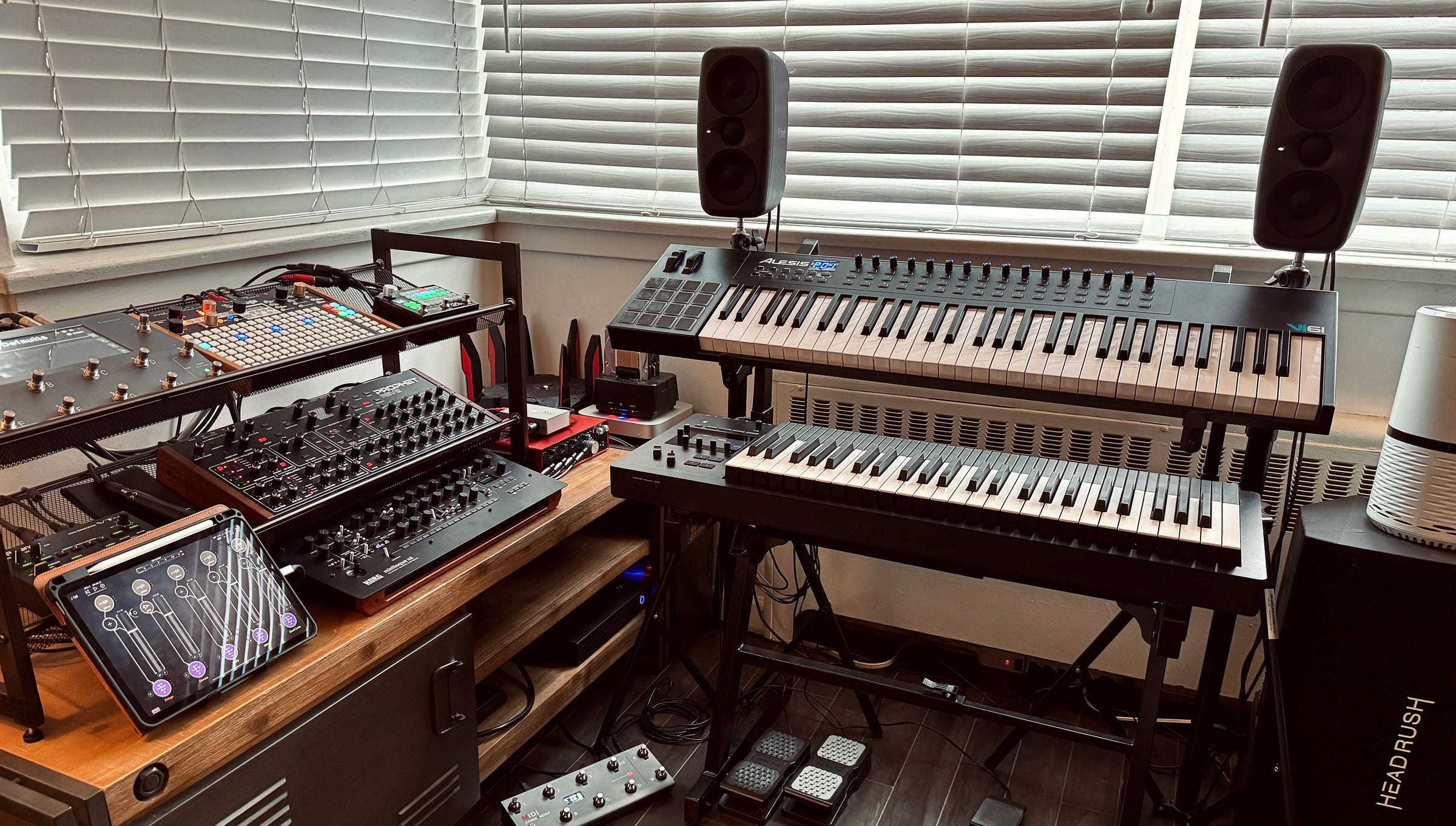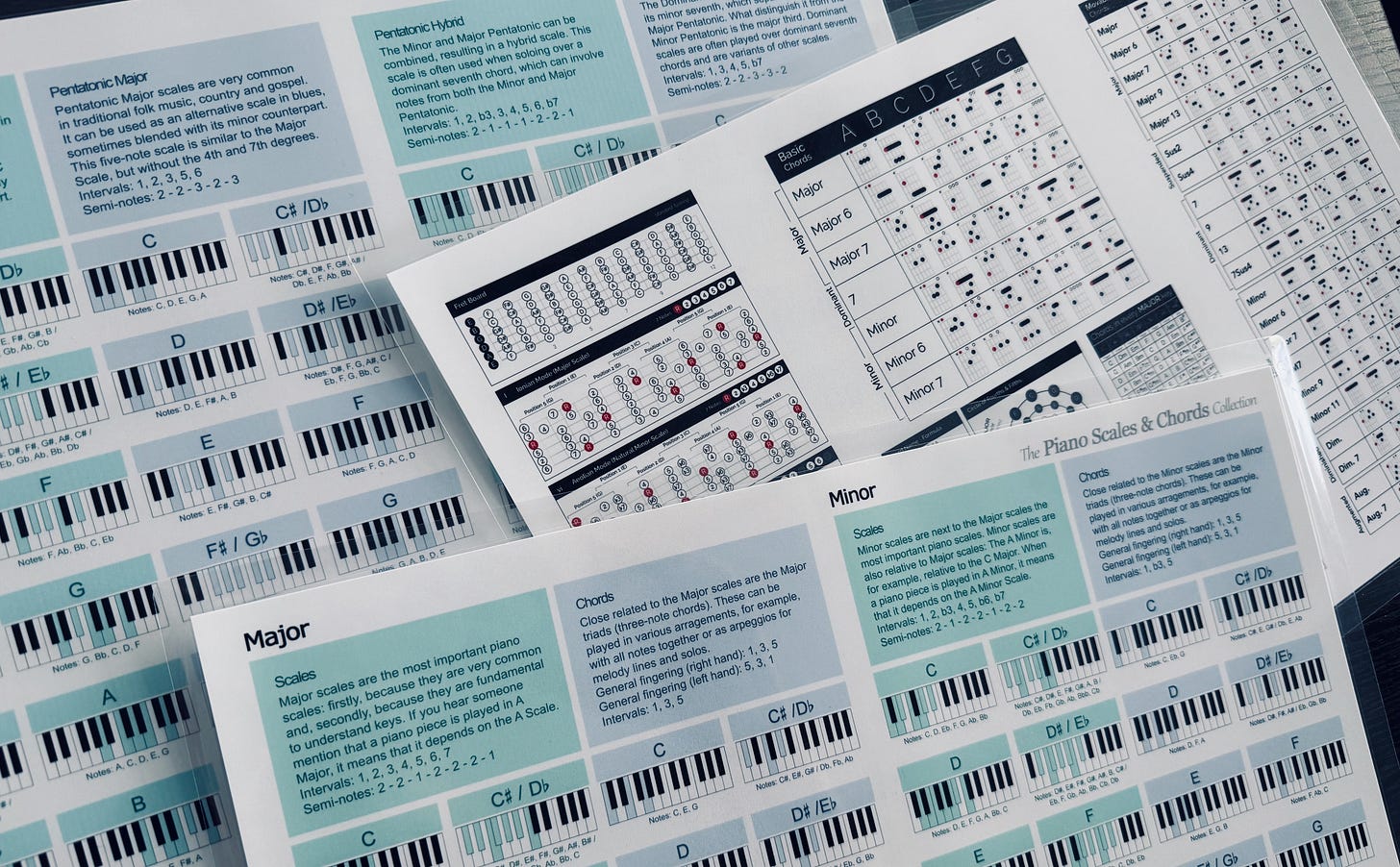Music Production Probability
Programming machines to produce infinitely symphonic jams as a way to put newly learned music theory into practice!
I’ve taken an extended break from creative coding for a few months now — more on that at the end — yet no matter what I do, I always find myself drawn to introducing methods of randomization in my creative pursuits, relinquishing some of my own agency to a machine so I may experience the delight of not knowing precisely what I will create with it. And now, my music hobby has succumbed to this obsession!
Music Study
I am not a student of music. I grew up teaching myself to play guitar by ear and reading tabs for songs I enjoyed, which are simple text files uploaded by other hobbyists that indicate where to place your fingers on the guitar neck. Instead of learning how to construct chords, I memorized finger positions, and instead of understanding what a key is and how to stay in it, I fumbled around the neck for what sounded good. Not a terrible approach, as it trained my ear, but certainly a far cry from being able to communicate and use the tools professional musicians employ daily. If only music education had incorporated modern music to give it some flavour and relevance, rather than relying solely on classical studies — an utter bore to a young mind that enjoys punk and metal.

Fast-forward 20 years, and I’m looking for a new musical hobby to complement my guitar skills. Having never given much thought to the bleeps and bloops that shape so much of the music I know, I stumbled upon synthesizers: fantastical boxes bursting with knobs, buttons, and blinking lights that would make any Star Trek fan with a home-built control console envious. But instead of piloting a starship, they transport you to other worlds through sound design. Even better, you can program them to play sequences on their own — I could jam along to my own tracks!
Synth that moment, I’ve slowly grown my collection and spent far more than I should have on a hobby. Early on I released an EP after learning the basics, but knew I needed to study my instruments more deeply and sound design itself (Syntorial is excellent for this). I experimented with various 8-bar loops and found inspiration from many musical artists on YouTube, so I started producing more tracks.
What I made sucked.
The kind of music only your Mom is proud of — thanks Mom ❤️
While you should always create for yourself, that doesn’t mean you shouldn’t strive to improve and share something others enjoy. I wasn’t going to uncover new insights or exciting opportunities in music production with what I was making, largely because I had hit the brick wall of my music theory ignorance.
There was no questioning it anymore — I needed to learn music theory (and better production techniques) if I wanted to progress. For a little over a year now, I’ve made a concentrated effort to learn everything I can about scales, modes, chord structures, progressions, inversions, composition, mixing, mastering, and more. I only wish I had done this when my brain was more plastic and adaptable. But as I apply what I’ve learned in my practice sessions, everything is starting to click. Now what?
Just… Make… Music!
Instead of making 8-bar loops in my “ideas” folder and calling it a day, my new mantra is to finish tracks. I’ve heard it said that you need to complete at least 100 tracks to find your sound and develop technical competence. So that’s what I’m doing; creating at least 100 raw jams and uploading them to YouTube. Along the way, if I really like a track, I may release it as a proper single or bundle a few into an album, but my primary goal is simply to finish producing music.
Producing with Probability
Great! I now have a production goal—but with so many competing theories and skills to practice, where do I begin!? Powering up all my gear and sitting down often left me overwhelmed with choices. More often than not, I’d just play something familiar to “get warmed up,” only to lose the time I had set aside for producing. Then I remembered an age-old tenet of the creative process…
Constraints inspire creativity!
But what kind of constraints should I choose? I could limit myself to a subset of my gear and see what I can create with it in isolation. Perhaps I could pick a genre and try composing in that style. Maybe I could do a cover song to focus on sound design and analyze how music theory was applied. Or what if I handed over composition entirely to my gear, using its generative features?
And there it was—the inevitable realization that I could apply my experience in algorithmic artwork to my music practice. Of course, I’ll still compose music traditionally, but algorithmic design offers a unique advantage.
By offloading many compositional decisions to the machines, I can constrain the overall scope of my work, allowing for deep focus in other areas. I’d have more time for sound design, intentional mixing, experimenting with different ways of triggering notes, adding nuance with occasional sounds, using post-effects creatively, and modulating everything over longer periods.
I started exploring these ideas in this generative jam track. It’s a bit dark and ugly, which I can only assume is my subconscious expressing itself from all the dread and anxiety I’ve felt over the last little while (🇨🇦😡👉…🎃🇺🇸), but I enjoyed making it and can’t wait to dig deeper into the generative features of the Deluge, M8 and Zoia!
Here’s hoping I can bring some more positive and calming energy in my next one ❤️
You haven’t been creative coding?
No, well… yes… but not in the way I have been for years now.
While I’ve loved working full-time as an algorithmic artist over the past few years, opportunities have been harder to come by lately. Last year, I dedicated significant time to a collaboration (with revenue split) that is now on indefinite hold due to market conditions. I also overhauled my website, art API, engine, and automation to prepare for the next phase of my art practice. I then invested in a fine art printer and launched my art shop — only to see zero sales.
I still have engaging work in progress — a different collaboration, a sculptural motion work seeking placement — but suffice to say I needed to re-think my career strategy.
ComboMash Games
I’ve wanted to develop and release an indie game for over a decade but never really had the development skills or maturity to tackle it. While re-evaluating how I want to run my art practice, I decided to get started on a Tactical RPG I’ve dreamed up over the years. So yes, I’ve been coding creatively, but not on anything directly related to this publication or my art practice. I guess it’s more of a time reallocation than taking a break, but in the end, it still means I haven’t been actively making artwork.
I won’t talk about my game here — only mentioning major milestones like when it’s launched or when a demo is released. Instead, I’ll simply invite you to subscribe.
Algorithmic Artist Persona
I haven’t quite figured out how I want my art practice to continue, other than knowing that I have ideas I need to express that are uniquely algorithmic in nature. Right now, I’m thinking that sharing more about my story feels like a path forward that makes sense. I’ve tried social media,(mostly just spamming images and links) and frankly, I hate it. It feels much more fitting to try and build an audience I can actually connect with, rather than playing the everyday engagement game.
I follow many creatives on YouTube who share their process of creating, how they feel regularly, and demonstrate the work they pour themselves into. They inspire me, not only through the messages they share but also through the freedoms they’ve earned thanks to their hard work in producing engaging content and connecting with fans.
https://www.youtube.com/@owmo_studio
I’m giving it a try by starting with sharing the musical journey I’m on—experimenting with content types, presentations, production techniques, etc. It’s fairly low-stakes right now, and will almost certainly shift over time as I find what works for me, the audience, and, more importantly, my time to create engaging artwork.
In starting this process, I’ve found that it has rekindled flames I thought were nearly snuffed out. Blowing a bit of oxygen back into my creative furnace has returned me to a state of excitement and imagination. I’m looking forward to getting back to making art that I can be proud of and sharing it with you all soon!



